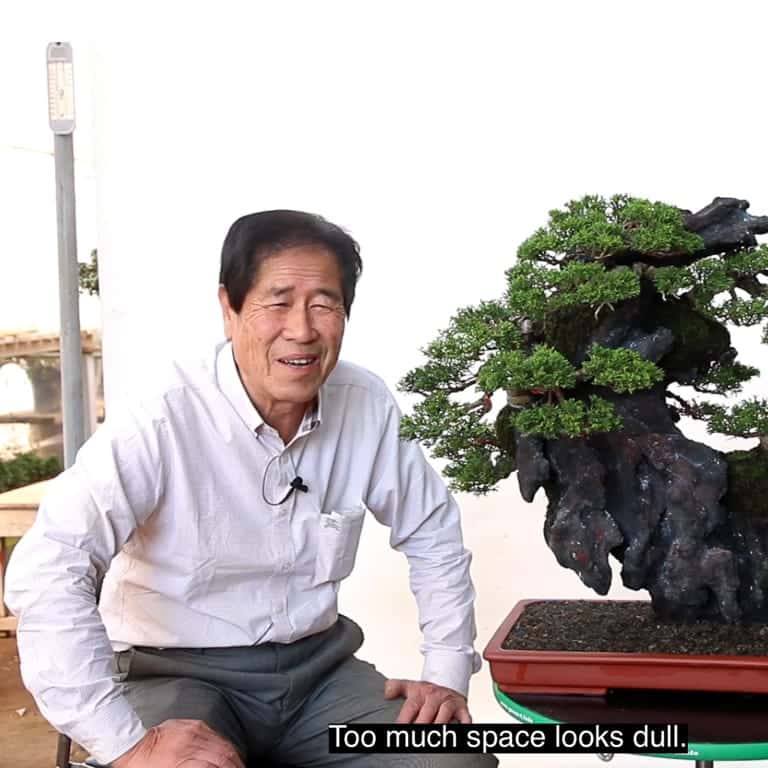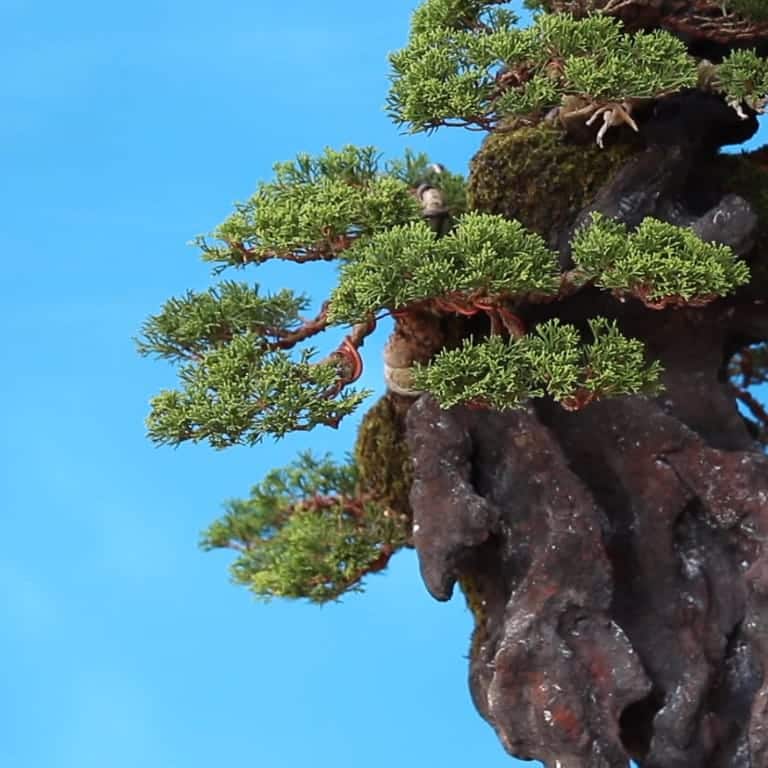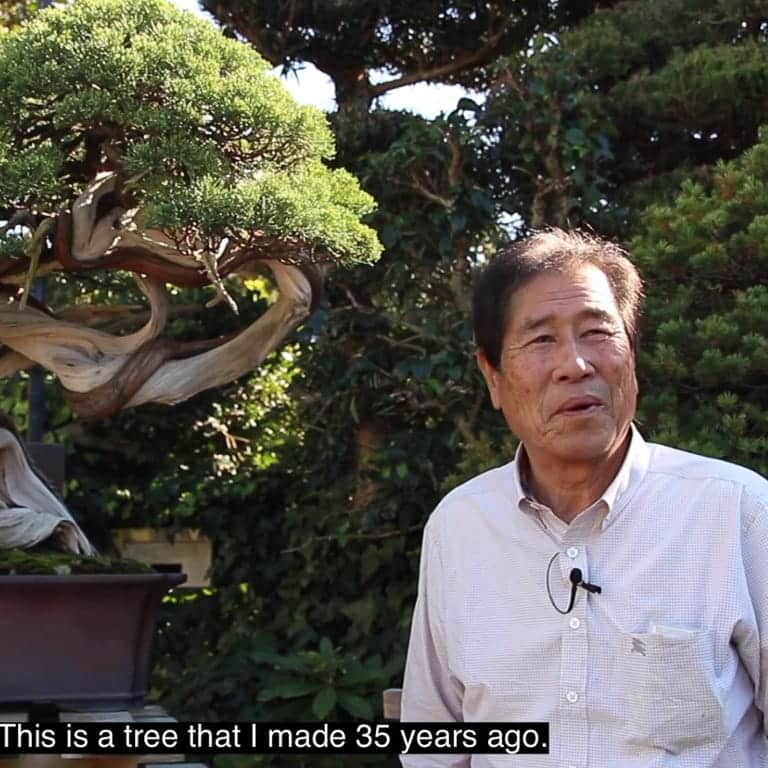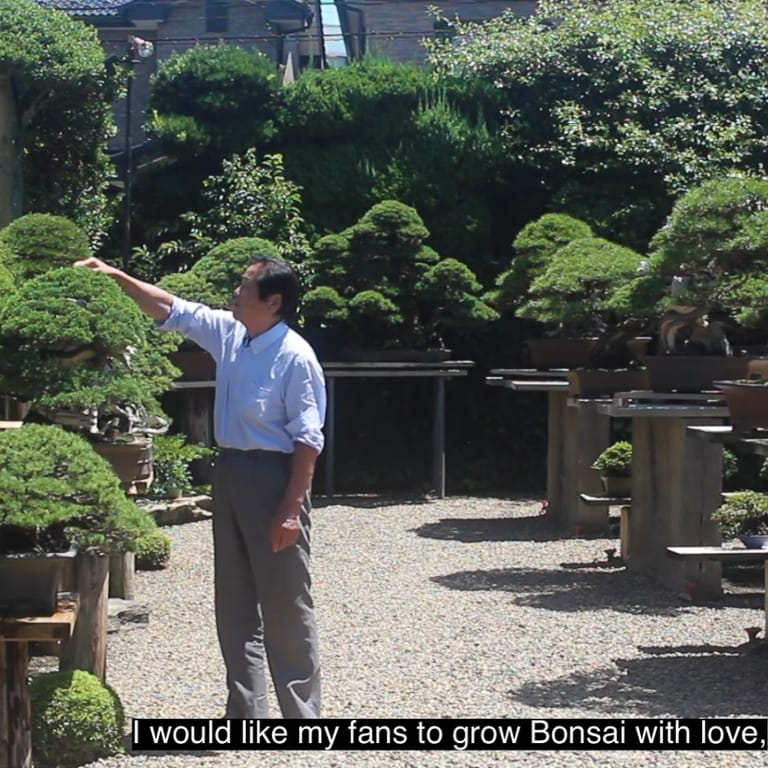Bonsai Empire’s newest online course features the best known name in bonsai: Masahiko Kimura.
The course was filmed last fall at Kimura’s garden about one hour outside of Tokyo. Here’s what you need to know.
Format
The course features a pine demo, a rock planting, an interview, and footage of Kimura’s public (front) and private (back) gardens. The footage of the back garden is particularly fun as this area is usually closed to visitors.
The course includes 14 videos (4+ hours) in Japanese with English subtitles.
Unlike past Bonsai Empire courses, the format focuses less on technical how-tos and instead offers a holistic view of Kimura’s approach.
The effect is like witnessing a relaxed demonstration. While Kimura works, an off-screen interviewer asks questions about what’s happening. Some of these questions prompt technical discussions of the work at hand, and other times it leads to more introspective replies.

Kimura getting to work on a collected white pine
The core videos from the hands-on sessions move at a good pace, but the fine wiring and branch setting sections were less engaging – no different, really, than what I’d expect from a live demonstration.

Setting the stone

Kimura discussing rock-planting design
Content
For anyone interested in creating a rock-planting, the videos on this topic cover the process in adequate detail to help you get started. Although the trees were pre-styled, Kimura discusses the placement of the trees, and the actual attachment to the stone is covered in great detail, including recipes for the muck in which the trees are planted. It was fun to see how quickly the composition came together.

The finished product – detail
The white pine demonstration covers everything from the health and history of the tree to decisions about which branches to keep and which to shorten or cut. Don’t expect lots of technical details here; do expect a close-up look at how Kimura styles a tree from start to finish.

Kimura in his garden
Who this course is for
I think the following groups will get the most out of this course:
- Fans of Kimura who want to see him work up-close or learn about his approach to bonsai
- Anyone who enjoys watching bonsai videos featuring high-level work
- Anyone who wants to learn how to create rock plantings

Kimura tending to the trees in his front garden
Do note: the course doesn’t cover the flashier techniques that made Kimura famous. There is no heavy bending, no use of power tools, and not a single chainsaw.
What you do get is insight to the soft skills that helped make Kimura successful. Examples include his precision when selecting the proper gauge wire for a branch and what to do if you don’t have the right size.
I also found myself focusing on how Kimura handled the trees. I enjoyed, for example, watching how he placed his hands on large branches when bending them. It’s hard to teach how to hold a branch when you bend it and Kimura shows that it may require several attempts with several different hand positions to achieve the desired result.
He doesn’t mention any of this as he works, but if you watch closely, you’ll find similar details that can inform how you work.
The details
The Kimura Masterclass is available from Bonsai Empire for 79.99. The fee covers unlimited lifetime access to the course. Learn more and check out free previews at the link below:
Kimura Masterclass presented by Bonsai Empire
Have any questions or comments about the course? Feel free to post them in the comments below!
Video Consultations Now Available
Have questions about your trees? Schedule an appointment to discuss strategies for improving your bonsai. Learn more about Bonsai Tonight’s Video Consulting.
English-language consultations are available worldwide.
Subscribe to Bonsai Tonight
New Posts Delivered Every Tuesday and Friday
Thomas Regelskik says
Thanks again for the information and insights.
However you seem to aim the site for very experienced bonsai artists working with the most sophisticated materials and designs–people who least need the refinements you offer. What about those of us staring at winter browning of our finest designs? How to we resuscitate them? Which species bought at the local garden shop are the most likely candidates for creative work? What are we looking to collect?
You show beautiful, usually very large trees, with lots of twisted and gnarled wood, examples that seem to me to violate the zen ethos of simplicity, straight-forward design (not always looking like the survivor of a massive storm)), and small size. What has happened to that strain of bonsai in your work?
Jonas Dupuich says
Hi Tom – thanks for the thoughtful response! Even though Bonsai Empire lists the Kimura Masterclass among their “Advanced Courses,” there are a lot of good takeaways for new students. One, it’s a good look at how one professional goes about his work. Two, it offers a good example of the start-to-finish process that applies to any material that has a mature trunk and branches, whether it came from the mountains, a garden center, or a neighbor’s garden. Two, the section that teaches rock planting is a good primer for students of all levels. Finally, people have found inspiration from the trees in Kimura’s garden for years. The brief garden tours suggest some of the beauty of Kimura’s garden and the interviews provide some insight into his famous trees.
I’d love to know more about what you suggest is simple, straightforward design, whether in my work or in the work of others. It doesn’t sound like anything that I’ve been able to accomplish up to this point – I’m still working on that!
Your questions about winter browning and what type of material to search out are good. The winter browning will take care of itself if the tree is healthy (it usually clears up with 1-2 months of warm weather). And as for what kind of material to search out, I’m long overdue for writing more articles on the topic! I haven’t had much of this material in the garden lately so I’ll start looking out for some.
In the meantime, please let me know if you – or anyone else reading! – have other suggestions and I’ll see what I can do. Thanks!
Yaroslav says
I wouldn’t argue that Bonsai Empire is aimed only at the pros. They have basic courses. Empire advanced courses are more focused on aesthetics, philosophy, rather than techniques. If you want to learn a variety of techniques and subtleties, as well as aesthetics an understanding of “what are we really doing X for” – a videos from Bonsai Mirai will suit you. I think these are truly advanced courses.